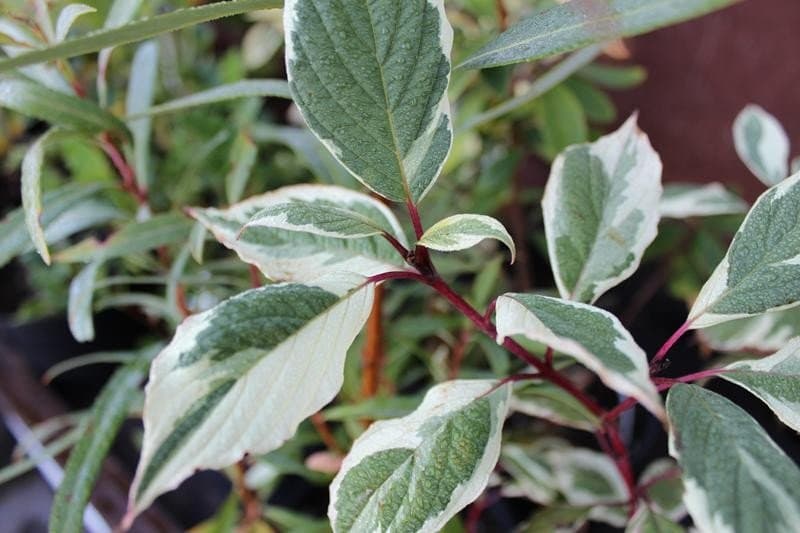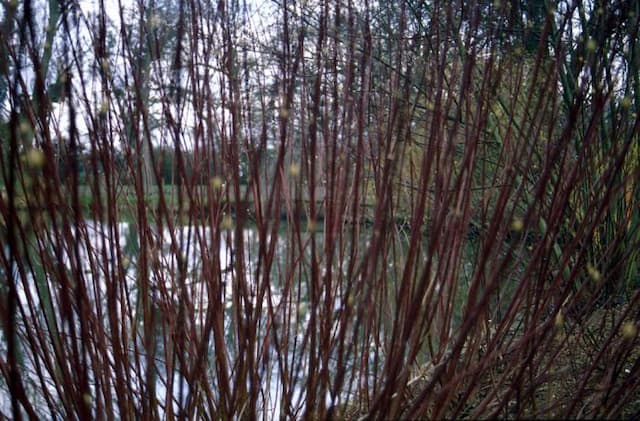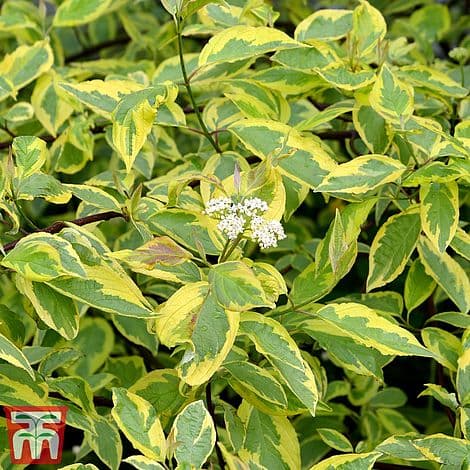Variegated Red Twig Dogwood Cornus alba 'Sibirica Variegata' (v)

ABOUT
The Red Twig Dogwood, known as 'Sibirica Variegata', is an ornamental shrub that boasts a striking variegated foliage. The leaves are characterized by a green center surrounded by white margins, creating a remarkable contrast that catches the eye. This variegation adds a splash of brightness to garden settings. During the growing season, the foliage provides a backdrop for clusters of flat-topped white flowers that can attract butterflies and other pollinators. As the seasons change, the leaves take on a reddish-purple tint, enhancing the autumnal landscape. One of the most distinctive features of this Red Twig Dogwood is its vivid red stems, which become especially prominent in the winter after the leaves have fallen. These bright red branches stand out against snowy backgrounds or more subdued winter scenes, adding color and interest during the colder months. The plant also produces small white to bluish-white fruit that can attract birds, providing both a food source for wildlife and an additional visual element in the garden. Overall, Red Twig Dogwood 'Sibirica Variegata' is a versatile and attractive shrub that offers multi-seasonal interest through its foliage, flowers, stems, and fruit.
About this plant
 Names
NamesFamily
Cornaceae.
Synonyms
Variegated Tartarian Dogwood, Variegated Red Twig Dogwood, Variegated Siberian Dogwood, Variegated Tatarian Dogwood.
Common names
Cornus alba 'Sibirica Variegata'
 Toxicity
ToxicityTo humans
The plant Cornus alba, commonly known as Tatarian Dogwood, is not considered highly toxic to humans. However, as with many plants, the ingestion of large quantities may cause some stomach upset. While toxicity is typically low, it's advised to keep an eye on children who might ingest plant material as a precaution.
To pets
Tatarian Dogwood is not known to be highly toxic to pets such as cats and dogs. If a pet ingests a small amount, it is unlikely to cause more than mild stomach upset. However, ingestion of a large amount could potentially lead to more severe gastrointestinal distress. As with humans, it is advisable to prevent pets from eating large quantities of any plant matter to avoid any potential issues.
 Characteristics
CharacteristicsLife cycle
Perennials
Foliage type
Deciduous
Color of leaves
Variegated
Flower color
White
Height
6 feet (1.8 meters)
Spread
5 feet (1.5 meters)
Plant type
Shrub
Hardiness zones
3
Native area
Siberia
Benefits
 General Benefits
General Benefits- Ornamental Appeal: The plant boasts striking variegated leaves, with white and green patterns that add aesthetic value to landscapes.
- Winter Interest: Bright red stems provide a splash of color during the dull winter months when many plants lose their vibrancy.
- Erosion Control: The dense rooting system of the Siberian Dogwood can help stabilize the soil and prevent erosion in certain areas.
- Wildlife Habitat: It offers shelter and sometimes food to birds and other wildlife within its dense foliage and branching structure.
- Easy Cultivation: This hardy shrub can thrive in a range of soil conditions and is relatively low maintenance, making it suitable for many gardeners.
- Seasonal Change: The leaves change throughout the seasons, delivering a dynamic experience as they transition from spring to fall.
- Boundary Definition: Can be used effectively as a border or hedge for defining the edges of a property or garden space.
 Medical Properties
Medical PropertiesThis plant is not used for medical purposes.
 Air-purifying Qualities
Air-purifying QualitiesThis plant is not specifically known for air purifying qualities.
 Other Uses
Other Uses- Crafting natural dyes: The bark and leaves of the red-barked dogwood can be used to create natural dyes for textiles, yielding colors that range from tans to rich browns.
- Winter interest in garden design: The bright red stems of the red-barked dogwood provide a vibrant contrast in gardens during the dull winter months when most plants have lost their leaves.
- Living structures: Flexible young stems of the red-barked dogwood can be woven into living fences, arches, or other garden structures that add visual interest throughout the year.
- Wildlife shelter: The dense branching pattern of the red-barked dogwood provides excellent shelter for birds and small animals, especially during harsh winter weather.
- Nesting sites: Birds often choose the thick foliage of the red-barked dogwood as a secure site for building nests in the spring.
- Photography subject: The striking variegated foliage and bright red stems make the red-barked dogwood a popular subject for garden and nature photographers.
- Educational tool: As a plant with distinctive seasonal changes, the red-barked dogwood is useful for teaching children and garden enthusiasts about plant growth and dormancy cycles.
- Soil stabilization: The red-barked dogwood's root system helps to prevent soil erosion on slopes and riverbanks, making it an eco-friendly choice for landscaping in problem areas.
- Floral arrangements: The colorful stems and variegated leaves of the red-barked dogwood can be incorporated into floral arrangements for a unique touch of natural beauty.
- Insect habitat: The plant provides a home for various beneficial insects that contribute to a healthy garden ecosystem by pollinating flowers and controlling pests.
Interesting Facts
 Feng Shui
Feng ShuiThe Red Twig Dogwood is not used in Feng Shui practice.
 Zodiac Sign Compitability
Zodiac Sign CompitabilityThe Red Twig Dogwood is not used in astrology practice.
 Plant Symbolism
Plant Symbolism- Resilience: The Cornus alba 'Sibirica Variegata', commonly known as Variegated Red Twig Dogwood, often symbolizes resilience because it can thrive in a wide range of climates and conditions.
- Purity: With its white-variegated leaves, this plant is sometimes associated with purity and innocence.
- Contrast and Balance: The striking contrast between the red stems and the variegated leaves can represent the idea of balance and the harmony of opposites.
- Growth and Renewal: As the plant can quickly regenerate after being cut back, it symbolizes new growth and renewal, reflecting the cycle of life.
 Water
WaterThe Variegated Red Twig Dogwood should be watered deeply to ensure the soil is moist but not waterlogged, generally receiving about 1 to 2 inches per week through rainfall or irrigation. During the first growing season, it's crucial to maintain consistent moisture to establish a strong root system, which might require watering two to three times per week. Once established, watering frequency can be reduced, and the plant may only need additional water during extended periods of drought. The exact amount of water can be adjusted based on the weather conditions and soil type, and it is better to use a soaker hose or drip irrigation for a gradual, deep watering effect.
 Light
LightThe Variegated Red Twig Dogwood thrives best in full sun to partial shade. An ideal spot for this plant would be an area that receives morning sunlight and partial shade in the afternoon, or dappled sunlight throughout the day. Adequate light is essential for the health of the plant and to maintain the vibrancy of its variegated leaves, although too much direct afternoon sun can scorch the foliage.
 Temperature
TemperatureThe Variegated Red Twig Dogwood is hardy and can withstand a temperature range from -30 to 100 degrees Fahrenheit. While it can survive these extremes, the ideal growing temperatures for this shrub are between 50 to 75 degrees Fahrenheit. It is important to protect the plant from harsh winter winds and excessively high summer temperatures to maintain its health and vigor.
 Pruning
PruningPruning the Variegated Red Twig Dogwood is important to encourage vibrant stem color, which is most pronounced on new growth. Prune in late winter or early spring before new growth begins, removing about a third of the oldest stems to ground level. This rejuvenation pruning should be done annually to maintain a healthy, vibrant shrub with strong, colorful twigs, and to prevent the plant from becoming too dense.
 Cleaning
CleaningAs needed
 Soil
SoilThe best soil mix for the Variegated Red Twig Dogwood should be well-draining, rich in organic material, and have a pH of 5.5 to 7.5 to ensure optimal growth.
 Repotting
RepottingVariegated Red Twig Dogwood, when grown in containers, should be repotted every 2-3 years to prevent root-bound conditions and replenish nutrients.
 Humidity & Misting
Humidity & MistingVariegated Red Twig Dogwood prefers average humidity levels but is adaptable to a range of conditions; it does not require special humidity considerations.
 Suitable locations
Suitable locationsIndoor
Grow in bright light, keep soil moist, protect from direct heat.
Outdoor
Plant in sun-partial shade, mulch, and water regularly.
Hardiness zone
3-7 USDA
 Life cycle
Life cycleCornus alba 'Sibirica Variegata', commonly known as Variegated Siberian Dogwood, begins its life as a seed which, after stratification, germinates in the spring. It rapidly establishes a root system and begins to shoot up stems with characteristic variegated leaves; a mixture of green with white margins. As the plant matures, it develops into a multi-stemmed shrub that flowers in late spring to early summer, producing small white blooms which are often followed by small blue-white berries that are favored by birds. Throughout the summer, the leaves provide visual interest in the landscape. In autumn, Variegated Siberian Dogwood sheds its leaves after they turn to shades of purple and red, and reveals brightly colored red stems that stand out in the winter landscape. The shrub either enters dormancy during the cold months, depending on the climate, or continues a slower pattern of growth until the cycle begins anew with the next spring's warmth.
 Propogation
PropogationPropogation time
Summer
The optimal time to propagate the Red Twig Dogwood, commonly known as Cornus alba 'Sibirica Variegata', is during the late winter or early spring, just before the growing season begins. The most popular method of propagation for this shrub is through hardwood cuttings. To propagate by this method, strong, healthy stems of the previous season's growth are selected. Cuttings should be about 6 to 9 inches (15 to 23 centimeters) in length and contain at least two sets of nodes. The bottom cut should be made just below a node, where there is a higher concentration of growth hormones to encourage root development. The top cut should be made at an angle to differentiate it from the bottom and to shed water away from the cutting. The cuttings can then be planted directly into the ground or into pots filled with a mixture of soil and compost, with about two-thirds of the cutting's length buried, ensuring that at least one set of nodes is below the surface.









